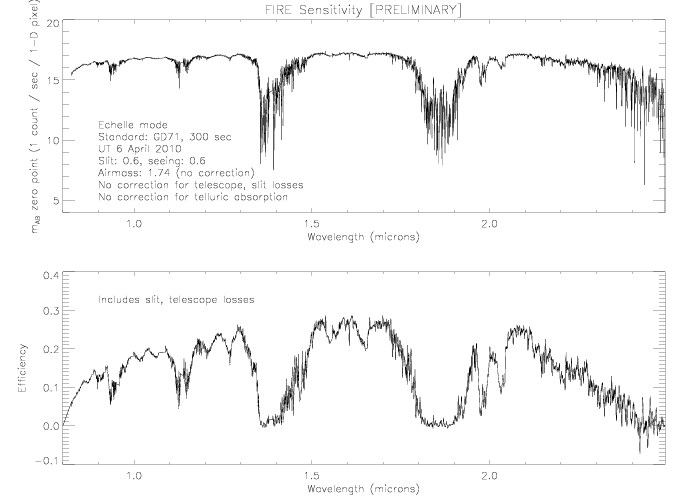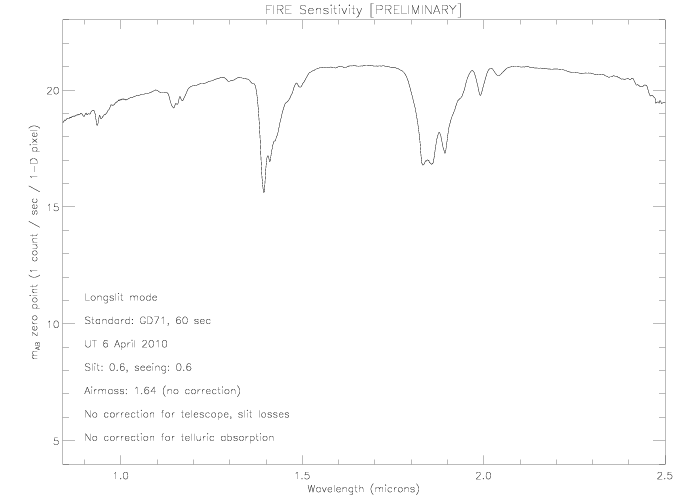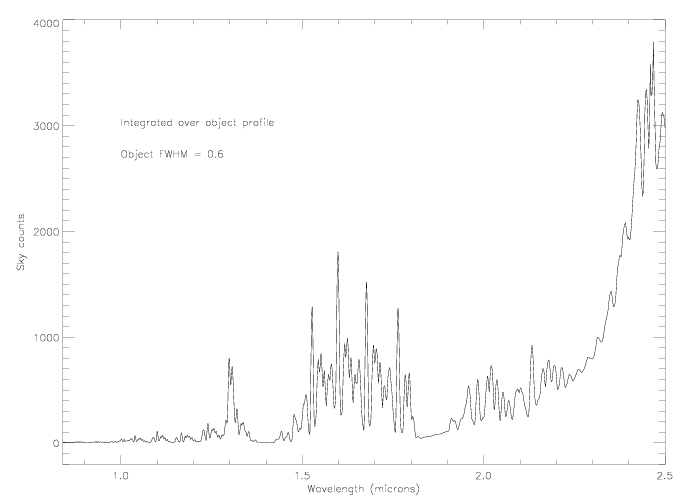|
Observers
FIRE is a near-infrared dual-mode spectrometer, which operates over the 0.82-2.51 micron wavelength range.
Its primary configuration is an echelle mode which delivers continuous single-shot spectra from Y throguh K bands at a resolution of R = 6000 - 8,000 (37.5-50 km/s) for a 0.60 or 0.45" slit.
FIRE was installed on the Magellan Baade telescope on March 29, 2010. The instrument team has obtained 9 nights of data as part of the instrument's shared-risk / installation phase. During 2010A, FIRE is only available for use via collaboration with the instrument team. We anticipate that it will be released for general use (under shared-risk conditions) during the 2010B semester.
PROPOSAL AIDS
Spectrograph Sensitivity
To aid in proposal preparation, we provide the following PRELIMINARY estimates of FIRE's sensitivity. The included figure presents an estimate of the zero point magnitude. This is defined as the AB magnitude which yields a detector flux of 1 DN per second per extracted 1-D pixel. At this time, we only include estimates for echelle mode, we will post numbers for longslit mode in the near future.
ECHELLE MODE

LONGSLIT MODE

NOTES ON ZERO POINT CALCULATIONS
1. The zero points do not include corrections for airmass, slit losses, or telescope losses. The numbers should be representative of reasonable conditions (clear, 0.6 arcsecond seeing) but at somewhat high airmass (1.74).
2. We have listed the zero point in AB magnitudes. For comparison with standard Vega magnitudes you must correct photometry accordingly, with the transformations being 0.941, 1.38, and 1.9 magnitudes in J, H, and K, respectively.
3. The slit was not at the parallactic angle for this observation, and may have been offset by 90 degrees. The slit viewer camera centers the object on the J band image of the target.
4. We expect to improve throughput by a few percent in subsequent engineering runs through improved alignment of the cold stop.
INSTRUMENT BACKGROUND
The following plot shows an estimate of the background count rate (counts / sec) in low-dispersion mode. The wavelength calibration is known to be off for this extraction but is good enough to aid in proposals. This plot shows the total count rate integrated over an object profile of 0.6 arcseconds FWHM. In other words, it is the sky background per extracted pixel, NOT the count rate per 1-D pixel. We have not yet stored the sky rate for echelle mode in an easily accessible format, but we will post this in upcoming weeks as it becomes available. Typically, exposure times should be limited to ~120 seconds or less to avoid saturation in K. These data were taken in high gain mode (1.34 e-/DN).

READ NOISE
For optimal noise performance, FIRE is read out in 4-amplifier mode.
FIRE's on-sky read noise is measured at 18.0, 12.6, 20.8, and 14.2 ADU per single CDS read, in the four respective amps. The detector may be read out using multiple non-desctructive Fowler samples to reduce the effect of read noise. The control software currently offers the option of averaging 1, 2, 4, 8, or 16 reads.
For these choices of Fowler sample numbers, the total noise scales well as 1/sqrt(N) where N is the number of Fowler pairs. Thus the total noise may be reduced to the range of 5-6 ADU RMS. However this induces a time penalty, as the chip readout incurs an overhead of roughly 20 seconds per CDS read.
The time penalty will be reduced as we implement sample-up-the-ramp mode in our software suite over the next semester. Although our noise performance meets FIRE's original spec, we do hope to improve upon these numbers: in the MIT lab and Las Campanas clean room we achieved CDS noise of 12-13 ADU in all amplifiers. We will continue to work on grounding schemes to bring the telescope performance into closer agreement with our lab numbers.
GAIN
Two choices of amplifier gain are offered. In normal operation, most users will select the high gain mode, of 1.34 e-/DN. This offers the most sensitivity and resolution, as well as the lowest noise performance. However this mode saturates at a relatively low count rate: approximately 20-25k ADU.
For bright targets where dynamic range is of higher importance, a low-gain mode is also offered with 3.8 e-/DN. This mode sees the entire full-well of the detector before saturation.
| 